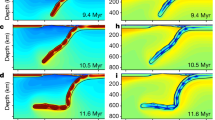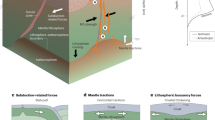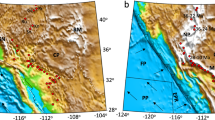Abstract
Structural features produced during the rifting of continents depend on the layered rheological properties of the crust and lithosphere and, in particular, on the presence of any transitions between brittle and ductile behaviour1. Here we use a wax model to explore the gross structural response of continental lithosphere under pure shear extension in the presence of a continuous brittle–ductile transition. The wax models were deformed under various boundary conditions to reflect a variety of different regions, most notably the Basin and Range province of North America. Our experiments show the development of listric normal faults, structures common to regions of continental extension. We also observe the formation of distributed and discrete rifting, and intrusion and occlusion of the upper brittle layer by the ductile lower layer. The factor controlling deformation style in each case appears to be the relative thickness of the brittle and ductile layers, although a relatively high rate of strain generally promotes discrete rifting.
This is a preview of subscription content, access via your institution
Access options
Subscribe to this journal
Receive 51 print issues and online access
$199.00 per year
only $3.90 per issue
Buy this article
- Purchase on Springer Link
- Instant access to full article PDF
Prices may be subject to local taxes which are calculated during checkout
Similar content being viewed by others
References
Coward, M. P., Dewey, J. F. & Hancock, P. L. Continental Extensional Tectonics (Spec. Publ. 28, Geol. Soc. London, 1987).
Oldenburg, D. W. & Brune, J. N. Ridge transform fault spreading pattern in freezing wax. Science 178, 301–304 (1972).
Oldenburg, D. W. Brune, J. N. An explanation for the orthogonality of ocean ridges and transform faults. J. Geophys. Res. 80, 2575–2585 (1975).
Yin, A. Origin of regional, rooted low-angle normal faults: a mechanical model and its tectonic implications. Tectonics 8, 469–482 (1989).
Spencer, J. E. & Chase, C. G. Role of crustal flexure in initiation of low-angle normal faults and implications for structural evolution of the Basin and Range province. J. Geophys. Res. 94, 1765–1775 1989).
Melosh, H. J. Mechanical basis for low-angle normal faulting in the Basin and Range province. Nature 343, 331–335 (1990).
Buck, W. R. Modes of continental lithospheric extension. J. Geophys. Res. 96, 20161–20178 (1991).
Longwell, C. R. Low-angle normal faults in the Basin and Range province. Eos 26, 107–118 (1945).
Wernicke, B. & Burchfiel, B. C. Modes of extensional tectonics. J. Struct. Geol. 4, 105–115 (1982).
Anders, M. H. & Christie-Blick, N. Is the Sevier Desert reflection of west-central Utah a normal fault? Geology 22, 771–774 (1994).
Wernicke, B. Low-angle normal faults and seismicity: a review. J. Geophys. Res. 100, 20159–20174 (1995).
Bradshaw, G. A. & Zoback, M. D. Listric normal faulting, stress refraction, and the state of stress in the Gulf Coast basin. Geology 16, 271–274 (1988).
Proffett, J. M. J. Cenozoic geology of the Yerington district, Nevada, and implications for the nature and origin of Basin and Range faulting. Geol. Soc. Am. Bull. 88, 247–266 (1977).
Vendeville, B. & Cobbold, P. R. How normal faulting and sedimentation interact to produce listric fault profiles and stratigraphic wedges. J. Struct. Geol. 10, 649–659 (1988).
Brun, J.-P., Sokoutis, D. & Van Den Driessche, J. Analog modeling of detachment fault systems and core complexes. Geology 22, 319–322 (1994).
Axen, G. J. Pore pressure, stress increase, and fault weakening in low-angle normal faulting. J. Geophys. Res. 97, 8979–8991 (1992).
Davis, G. A. & Lister, G. S. in Processes in Continental Lithospheric Deformation (ed. Clark, S. P. J.) 133–159 (Spec. Pap. 218, Geol. Soc. Am., Boulder, 1988).
Scott, R. J. & Lister, G. S. Detachment faults: evidence for a low-angle origin. Geology 20, 833–836 (1992).
Crittenden, M. D., Coney, P. J. Jr & Davis, G. H. in Cordilleran Metamorphic Core Complexes (Mem. 153, Geol. Soc. Am, Boulder, 1980).
Wernicke, B. in Exposed Cross-sections of the Continental Crust (eds Salisbury, M. H. & Fountain, D M.) 509–544 (Kluwer Academic, Boston, MA, 1990).
Hauser, E. et al. Crustal structure of eastern Nevada from COCORP deep seismic reflection data. Geol. Soc. Am. Bull. 99, 833–844 (1987).
Kruse, S., McNutt, M., Phipps-Morgan, J. & Royden, L. Lithospheric extension near Lake Mead, Nevada: a model for ductile flow in the lower crust. J. Geophys. Res. 96, 4435–4456 (1991).
Gans, P. B. An open-sysetm, two-layer crustal stretching model for the eastern Great Basin. Tectonics 6, 1–12 (1987).
Block, L. & Royden, L. H. Core complex geometries and regional scale flow in the lower crust. Tectonics 9, 557–567 (1990).
Bird, P. Lateral extrusion of lower crust from under high topography, in the isostatic limit. J. Geophys. Res. 96, 10275–10286 (1991).
King, G. & Ellis, M. The origin of large local uplift in extensional regions. Nature 348, 689–693 (1990).
Coney, P. J. in Cenozoic Tectonics and Regional Geophysics of the Western Cordillera (eds Smith, R. B. & Eaton, G. P.) 33–50 (Geol. Soc. Am., Boulder, CO, 1978).
Jackson, M. P. A. & Vendeville, B. Regional extension as a geologic trigger for diapirism. Geol. Soc. Am. Bull. 106, 57–73 (1994).
Mancktelow, N. S. The rheology of paraffin wax and its usefulness as an analogue for rocks. Geol Inst. Univ. Uppsala 14, 181–193 (1988).
McKenzie, D. & Bickle, M. J. The volume and composition of melt generated by extension of the lithosphere. J. Petrol. 29, 625–679 (1988).
Hildenbrand, T. G. Rift structure of the northern Mississippi embayrnent from the analysis of gravity and magnetic data. J. Geophys. Res. 90, 12607–12622 (1985).
Jones, C. H., Kanamori, H. & Roecker, S. W. Missing roots and mantle 'drips': regional Pn and teleseismic arrival times in the southern Sierra Nevada and vicinity. J. Geophys. Res. 99, 4567–4601 (1994).
Author information
Authors and Affiliations
Rights and permissions
About this article
Cite this article
Brune, J., Ellis, M. Structural features in a brittle–ductile wax model of continental extension. Nature 387, 67–70 (1997). https://doi.org/10.1038/387067a0
Received:
Accepted:
Issue Date:
DOI: https://doi.org/10.1038/387067a0
This article is cited by
-
Three-stage tectonic subsidence and its implications for the evolution of conjugate margins of the southwest subbasin, South China Sea
Journal of Oceanology and Limnology (2021)
-
Integrating external biological knowledge in the construction of regulatory networks from time-series expression data
BMC Systems Biology (2012)
-
Evolution of cis-regulatory elements in yeast de novo and duplicated new genes
BMC Genomics (2012)
-
Rational design for over-production of desirable microbial metabolites by precision engineering
Antonie van Leeuwenhoek (2010)
-
Augmenting the bootstrap to analyze high dimensional genomic data
TEST (2008)
Comments
By submitting a comment you agree to abide by our Terms and Community Guidelines. If you find something abusive or that does not comply with our terms or guidelines please flag it as inappropriate.



